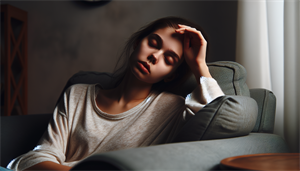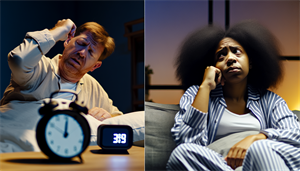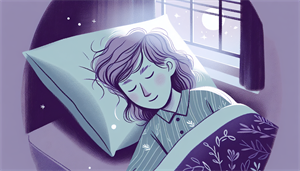Have you ever found yourself unable to stay awake during the day, or feeling chronically tired despite a full night’s sleep? These could be more than just symptoms of a busy life; they could be signs of chronic fatigue and sleep apnea. These are intricate conditions, each presenting a maze of symptoms that often overlap, leading to challenges in their diagnosis and management.
These conditions, although distinct, share common ground. The persistent fatigue associated with Chronic Fatigue Syndrome (CFS) often mirrors the excessive daytime sleepiness seen in sleep apnea patients. In this article, we will navigate through the complexities of these conditions, their intersection, and the strategies to manage chronic fatigue and sleep apnea effectively.
Key Takeaways
-
Chronic Fatigue Syndrome (CFS) is characterized by profound, persistent fatigue that doesn’t improve with rest, accompanied by symptoms such as non-restorative sleep, muscle pain, and cognitive difficulties without a specific diagnostic test.
-
Sleep apnea, both obstructive and central types, leads to interrupted breathing during sleep, causing symptoms that include loud snoring, excessive daytime sleepiness, and fatigue, which can be similar to those of CFS.
-
Effective management of CFS and sleep apnea overlaps due to shared symptoms requires a comprehensive approach, including sleep studies for accurate diagnosis and treatments such as CPAP for sleep apnea and holistic options for CFS.
Understanding Chronic Fatigue Syndrome (CFS) and Its Symptoms

Chronic Fatigue Syndrome (CFS) is a condition characterized by:
-
Persistent and unexplained fatigue that lasts at least six months
-
Non-restorative sleep
-
Post-exertion malaise
-
Cognitive impairments
It predominantly affects women and was initially defined in 1988. Medical professionals have been perplexed by this condition due to its multifaceted nature and the absence of specific tests for diagnosis.
CFS is often characterized by a debilitating exhaustion that extends beyond mere tiredness and does not improve with rest. This profound fatigue is typically accompanied by muscle pain and cognitive difficulties, adding layers of complexity to the condition.
Moreover, CFS patients often experience the following symptoms:
-
Sleep disturbances, characterized by profound fatigue and difficulties falling asleep
-
Cognitive impairments and dizziness when standing, which can worsen sleep problems
-
Muscle pain, resulting from bioenergetic muscle dysfunction and overuse of the lactate dehydrogenase pathway
-
Slower clearance of acid after exercise
These symptoms contribute to the overall experience of chronic fatigue syndrome.
The Persistent Fatigue Dilemma
The question arises - why is the fatigue in CFS so persistent? The complex nature of the condition holds the answer. The profound fatigue associated with CFS fails to alleviate with rest and impacts multiple body systems, while its origin remains unidentified. This is not a simple case of feeling tired; it’s a state of constant exhaustion that doesn’t improve with rest, making daily activities a challenge.
In addition to persistent fatigue, muscle pain and cognitive difficulties often manifest in CFS, further complicating the condition. The muscle pain in CFS arises from bioenergetic muscle dysfunction, leading to an overuse of the lactate dehydrogenase pathway and slower clearance of acid after exercise. Cognitive difficulties, often referred to as ‘brain fog’, can include problems with thinking, memory loss, and vision problems.
Beyond Tiredness: Additional CFS Symptoms
Alongside the debilitating fatigue, CFS also presents a host of additional symptoms that extend beyond mere tiredness. These symptoms, varying from patient to patient, can include cognitive impairment, sleep disturbances, and muscle pain.
Furthermore, sleep disruptions are commonly experienced by CFS patients. These disturbances include:
-
Profound fatigue
-
Difficulties falling asleep
-
Cognitive impairments
-
Dizziness when standing
The condition, known as periodic limb movement disorder, may also present with muscle pain, which stems from bioenergetic muscle dysfunction, leading to an overuse of the lactate dehydrogenase pathway and slower clearance of acid after exercise.
Sleep Apnea Explored: Types, Causes, and Symptoms

Similar to CFS, sleep disordered breathing conditions like sleep apnea are complex and characterized by intermittent breathing during sleep. Sleep apnea is primarily of two types - obstructive sleep apnea and central sleep apnea. Obstructive sleep apnea occurs when the muscles in the back of the throat excessively relax and obstruct the airway during sleep. On the other hand, central sleep apnea is defined by a deficiency in the brain’s ability to transmit appropriate signals to the respiratory muscles.
Common complaints from patients with sleep apnea include loud snoring, fatigue, and excessive daytime sleepiness, which make it challenging to stay awake during the day, maintain concentration, and perform daily tasks. Central sleep apnea, though less prevalent, also leads to significant fatigue, daytime drowsiness, and irritability, much like CFS.
Interestingly, the symptoms of sleep apnea appear in both adults and children, although they may manifest differently. Some common symptoms include:
-
Loud snoring
-
Gasping for air during sleep
-
Excessive daytime sleepiness
-
Behavior issues (in children)
-
Breathing difficulties (in children)
-
Restlessness (in children)
-
Increased sweating (in children)
Adults with sleep apnea are more prone to displaying daytime sleepiness and fatigue, whereas children lean more towards behavior issues, breathing difficulties, restlessness, and increased sweating.
Obstructive vs. Central Sleep Apnea
While both obstructive and central sleep apnea disrupt sleep and cause daytime fatigue, their underlying causes differ. Obstructive sleep apnea occurs when the muscles in the back of the throat relax excessively and obstruct the airway during sleep. Its primary causes include muscle relaxation, excess weight, and obesity.
On the other hand, central sleep apnea is defined by a deficiency in the brain’s ability to transmit appropriate signals to the respiratory muscles. It does not involve muscular obstruction and is comparatively less prevalent. This highlights the importance of a comprehensive evaluation of symptoms to distinguish between the two types of sleep apnea.
Recognizing Sleep Apnea Symptoms
Recognizing the symptoms of sleep apnea is crucial for its timely diagnosis and management. The most common symptoms include loud snoring, gasping for air during sleep, and excessive daytime sleepiness. Symptoms of both obstructive and central sleep apneas are similar. They include pauses in breathing and excessive daytime sleepiness..
However, the symptoms of sleep apnea can manifest differently in adults and children. Adults with sleep apnea are more prone to displaying daytime sleepiness and fatigue, whereas children lean more towards behavior issues, breathing difficulties, restlessness, and increased sweating. In severe cases, symptoms such as severe fatigue, significant daytime drowsiness, and extreme tiredness are indicative of the severity of sleep apnea.
The Intersection of Chronic Fatigue and Sleep Apnea

Despite being distinct conditions, CFS and sleep apnea share common ground. Both conditions manifest with fatigue and sleep disturbances, including excessive daytime sleepiness (EDS) and non-restorative sleep. This overlap in symptoms can result in potential misdiagnosis or overlapping diagnoses.
In fact, research suggests that a significant overlap between these conditions exists, with 46% of CFS patients meeting the criteria for Obstructive Sleep Apnea (OSA). This finding highlights the necessity of comprehensive evaluation for ensuring accurate diagnosis and effective treatment.
However, the overlapping symptoms of these conditions pose a diagnostic challenge. Fatigue and sleep disturbances are non-specific symptoms, making it difficult to differentiate between the two conditions based on these symptoms alone. Thus, to accurately diagnose and distinguish between CFS and sleep apnea, a comprehensive evaluation that incorporates sleep studies and questioning about sleep-related symptoms is essential.
Shared Symptoms: Fatigue and Daytime Sleepiness
Fatigue and daytime sleepiness are shared symptoms of CFS and sleep apnea. Both these conditions manifest with profound fatigue that does not alleviate with rest and impacts multiple body systems, although their causes may differ. Daytime sleepiness, often a result of obstructed airflow and disrupted sleep patterns in sleep apnea, can mimic the persistent fatigue seen in CFS.
This overlap in symptoms complicates the diagnostic process. Profound fatigue and sleep disturbances, which are non-specific symptoms, can result from both conditions. This can result in potential misdiagnosis or overlapping diagnoses, underscoring the need for a comprehensive evaluation and a high index of suspicion in clinical practice.
Diagnosing the Overlap: Challenges and Considerations
The diagnostic challenge stems from the overlapping symptoms of CFS and sleep apnea. Both conditions manifest with fatigue and sleep disturbances, which are non-specific symptoms. This can result in potential misdiagnosis or overlapping diagnoses, making accurate diagnosis a complex task.
Distinguishing between the two conditions necessitates a comprehensive evaluation, including sleep studies. It ensures that both conditions are accurately diagnosed, and suitable treatment is provided. This is particularly important as sleep disorders commonly co-occur with CFS, with rates of concurrent sleep disorders ranging from 13% to 68% depending on the specific type.
Impact of Sleep Disorders on Chronic Fatigue Syndrome

Sleep disorders, including sleep apnea, can contribute to the exacerbation of CFS by precipitating and worsening symptoms such as fatigue, pain, and mood disturbances. They can act independently and complicate the overall health and well-being of the patient.
In particular, sleep apnea can significantly impact CFS. By disrupting sleep homeostasis and basic sleep drive, it can result in symptoms such as fatigue, tiredness, and lack of energy. Therefore, addressing underlying conditions such as sleep disorders can play a role in reducing symptoms associated with CFS.
Acknowledging and addressing these comorbid conditions is vital for effective CFS management. This approach not only helps alleviate symptoms but also improves the overall quality of life for patients.
Sleep Quality and Chronic Fatigue
There is a clear link between sleep quality and chronic fatigue. A common symptom of CFS, non-restorative sleep, is characterized by waking up tired despite sufficient sleep. Sleep apnea can disrupt sleep patterns, leading to frequent interruptions, affecting deep sleep, and reducing overall sleep quality.
This disruption of sleep can contribute to chronic fatigue and worsen symptoms of CFS, leading to a vicious cycle of sleep deprivation. However, enhancing sleep quality has been linked to decreased fatigue in individuals with CFS, highlighting the importance of addressing sleep quality in the management of this condition.
Comorbid Conditions: When Sleep Disorders Meet CFS
Sleep disorders, such as sleep apnea and restless legs syndrome, commonly co-occur with CFS, with rates of concurrent sleep disorder ranging from 13% to 68% depending on the specific type. These conditions can have a substantial impact on patient quality of life, as they can exacerbate CFS symptoms, thus making them a crucial consideration in patient management. Some common sleep disorders that co-occur with CFS include:
-
Insomnia
-
Sleep apnea
-
Restless legs syndrome
-
Narcolepsy
It is important for healthcare providers to assess and address primary sleep disorders in order to effectively manage CFS symptoms and improve patient outcomes.
Addressing these comorbid conditions is key to managing CFS effectively. Sleep disorders can exacerbate symptoms in CFS patients, increasing fatigue, pain, and mood disturbances. Identifying and treating these conditions can help alleviate symptoms and enhance the overall well-being of the patient.
Treatment Strategies for Converging Conditions
Managing sleep apnea and chronic fatigue simultaneously requires a comprehensive and integrated approach. This approach encompasses accurate diagnosis, effective management, and regular follow-up appointments. The importance of this approach cannot be overstated as it ensures a comprehensive evaluation and a tailored treatment plan that addresses both conditions.
Treatment options for managing sleep apnea and chronic fatigue include medications, therapies, and lifestyle modifications. While continuous positive airway pressure (CPAP) therapy is considered the most effective treatment for sleep apnea, holistic treatments, including symptom relief, physical activity, cognitive-behavioral therapy, and stress management, are effective in managing CFS.
Regardless of the specific treatment plan, the ultimate objective is to alleviate symptoms and enhance the overall quality of life for patients. Regular follow-up appointments provide the opportunity to make essential adjustments to the treatment plan and to assess its effectiveness over time.
Managing Sleep Apnea: Therapies and Lifestyle Changes
Continuous Positive Airway Pressure (CPAP) therapy is widely regarded as the most effective treatment for sleep apnea. It works by delivering a continuous flow of air through a mask worn over the nose or mouth. The air pressure generated by the machine maintains the openness of the airway, thus averting collapse or obstruction and enabling uninterrupted breathing.
In addition to CPAP therapy, lifestyle modifications can also be beneficial in managing sleep apnea. These include:
-
Weight loss
-
Increased physical activity
-
Cessation of alcohol and tobacco use
-
Avoidance of specific medications
-
Altering sleep positions
Addressing Chronic Fatigue: Holistic Management
A holistic approach that focuses not just on the symptoms but also on the overall well-being of the patient is required to manage CFS. Effective holistic treatments for managing CFS include:
-
Essential fatty acids
-
Vitamin B12 and folic acid
-
Coenzyme Q10
-
NADH
-
DHEA
-
L-carnitine
-
Nutrition strategies
-
Acupuncture
-
Cognitive behavioral therapy
-
Herbs
-
Supplements
-
Ginseng root
Physical activity, specifically through exercise therapy, contributes to the management of CFS by gradually reintroducing activities to mitigate fatigue and enhance daily functioning. Cognitive-Behavioral Therapy (CBT) is another effective approach, helping enhance physical function, alleviate fatigue, and modify behaviors and beliefs that sustain symptoms.
Enhancing Sleep Hygiene for Better Health

Enhancing sleep hygiene plays a vital role in supporting recovery from sleep apnea and chronic fatigue. Sleep hygiene encompasses behaviors and environmental recommendations aimed at facilitating healthy sleep. Good sleep hygiene can result in:
-
Heightened daytime vitality
-
Enhanced mood
-
Strengthened immune system function
-
Reduced stress
-
Overall enhancement in quality of life.
Establishing consistent sleep patterns can improve sleep quality. Here are some tips to help you achieve this:
-
Make gradual, consistent adjustments to your sleep schedule
-
Set up a healthy sleep environment
-
Maintain a consistent sleep schedule
-
Establish a relaxing bedtime routine
-
Avoid caffeine and electronic devices before bed
-
Limit daytime napping
-
Manage stress
By following these tips and considering sleep medicine, you can improve your sleep quality and overall well-being.
Another critical aspect of good sleep hygiene is the creation of a restful sleep environment. This includes:
-
Regulating the room temperature
-
Minimizing noise
-
Darkening the room
-
Utilizing calming scents
-
Maintaining room tidiness
-
Including comforting elements like photographs of loved ones.
Establishing Regular Sleep Patterns
The regulation of the body’s internal clock, or circadian rhythms, which govern vital bodily functions such as sleep and hormone release, relies significantly on consistent sleep schedules. Establishing a consistent sleep schedule can enhance sleep quality, including slow wave sleep, by maintaining the circadian rhythm, placing importance on sleep, engaging in relaxation techniques, refraining from taking naps, participating in regular physical activity, establishing a bedtime routine, evaluating the bedroom environment, and being conscious of light exposure.
Adopting a consistent sleep schedule helps regulate the body’s internal clock, improving sleep quality. Here are some tips to help you establish a consistent sleep schedule:
-
Make gradual, consistent adjustments to your sleep schedule.
-
Set up a healthy sleep environment.
-
Maintain a consistent sleep schedule.
-
Establish a relaxing bedtime routine.
-
Avoid caffeine and electronic devices before bed.
-
Limit daytime napping.
-
Manage stress.
By following these tips, you can improve your sleep quality and feel more rested.
Crafting a Restful Sleep Environment
The foundation of good sleep hygiene is the creation of a restful sleep environment. This includes:
-
Regulating the room temperature
-
Minimizing noise
-
Darkening the room
-
Utilizing calming scents
-
Maintaining room tidiness
-
Including comforting elements like photographs of loved ones
The impact of noise on sleep quality cannot be overstated. Noise can disrupt sleep patterns, reduce the duration of deep-stage sleep, and make it difficult to fall and stay asleep, resulting in poor sleep quality. Therefore, controlling noise levels is crucial to promoting a restful sleep environment.
Additionally, the quality and type of mattress and bedding can have a significant impact on sleep quality.
Lifestyle Modifications to Support Recovery
Lifestyle modifications also play a role in managing sleep apnea and chronic fatigue. These modifications, which include changes in diet, physical activity, and stress reduction, can play a significant role in managing these conditions.
Significant improvements in energy levels and overall health can be achieved through a balanced diet and regular exercise. Here are some tips to help manage CFS symptoms:
-
Avoid foods that can worsen symptoms, such as processed foods, sugary snacks, and caffeine.
-
Follow a diet rich in polyunsaturated and monounsaturated fats, such as fish, nuts, and avocados.
-
Incorporate gentle and low-impact exercises into your routine, such as walking, yoga, or swimming, to enhance energy levels without causing excessive strain.
By following these guidelines, you can support your body and manage the symptoms of CFS more effectively.
Alongside diet and exercise, stress management and relaxation techniques can contribute to alleviating symptoms of both sleep apnea and chronic fatigue. Mindfulness practices such as meditation and mindfulness-based therapies have shown promise as an adjunct therapy to traditional treatment methods for sleep apnea management.
Nutritional Choices and Physical Activity
In the management of sleep apnea and chronic fatigue, a balanced diet and regular exercise hold a pivotal role. Individuals with CFS should avoid foods such as:
-
Caffeine
-
Added sugars
-
Fried foods
-
White rice and pasta
-
Hydrogenated oils
-
Inflammatory foods
A diet rich in polyunsaturated and monounsaturated fats while steering clear of saturated fats and refined foods is also beneficial.
Exercise is another important aspect of managing these conditions. Gentle and low-impact exercises are particularly beneficial for individuals with CFS. These exercises include:
-
Reclined or recumbent exercises
-
Warm-water exercise
-
Yoga
-
Qigong (similar to Tai chi)
-
Pilates
-
Stretching
-
Seated tai chi
Stress Reduction and Mindfulness Practices
Significant alleviation of symptoms of sleep apnea and chronic fatigue can be achieved by managing stress and practicing relaxation techniques. Some stress reduction techniques that can help include:
-
Deep breathing exercises
-
Meditation
-
Yoga
-
Progressive muscle relaxation
-
Guided imagery
These techniques can aid in alleviating the exacerbating effects of emotional distress, addressing stress and chronic pain, and diminishing the intensity and frequency of symptoms.
Mindfulness practices such as meditation and mindfulness-based therapies have shown promise as an adjunct therapy to traditional treatment methods for sleep apnea management. They have been found to improve sleep quality, reduce insomnia symptoms, and positively impact the control of sleep-wake cycles.
Summary
Chronic Fatigue Syndrome and sleep apnea, although distinct, share common symptoms and challenges. The complexities of these conditions, their overlapping symptoms, and diagnostic challenges necessitate an integrated and comprehensive approach to their management. This includes accurate diagnosis, effective management, and regular follow-up appointments to assess the effectiveness of the treatment plan over time.
The journey towards better health involves not just medical interventions but also lifestyle modifications. Enhancing sleep hygiene, establishing regular sleep patterns, creating a restful sleep environment, and making nutritional choices can significantly improve the quality of life for individuals with sleep apnea and chronic fatigue. Regular physical activity, stress reduction, and mindfulness practices further contribute to managing these conditions effectively.
Frequently Asked Questions
Can you have chronic fatigue and sleep apnea?
Yes, there is a link between chronic fatigue syndrome and sleep apnea, with approximately 60% of patients with chronic fatigue syndrome also suffering from sleep apnea.
What does a CFS crash feel like?
A CFS crash can feel like having "flu-like symptoms" such as profound fatigue, weakness, fever, headache, and muscle pain, worsened cognitive symptoms like brain fog, and increased sensitivity to stimuli. During post-exertional malaise, any ME/CFS symptoms may get worse or first appear, including difficulty thinking, problems sleeping, sore throat, headaches, feeling dizzy, or severe tiredness.
What is extreme fatigue that doesn't go away with rest?
If you are experiencing extreme fatigue that doesn't improve with rest, you may be suffering from myalgic encephalomyelitis/chronic fatigue syndrome (ME/CFS). This condition causes long-lasting fatigue and worsens with physical or mental activity. Its exact cause is unknown.
What is the new treatment for chronic fatigue syndrome?
The new treatment for chronic fatigue syndrome involves oral Anhydrous Enol-Oxaloacetate capsules, which have shown significant reductions in physical and mental fatigue within 6 weeks among patients with ME/CFS and Long-COVID. This highlights a promising development in addressing pathological fatigue prevalent in these conditions.
What is the significance of a comprehensive evaluation in diagnosing sleep apnea and Chronic Fatigue Syndrome?
A comprehensive evaluation is significant in accurately diagnosing and effectively treating both sleep apnea and Chronic Fatigue Syndrome.


